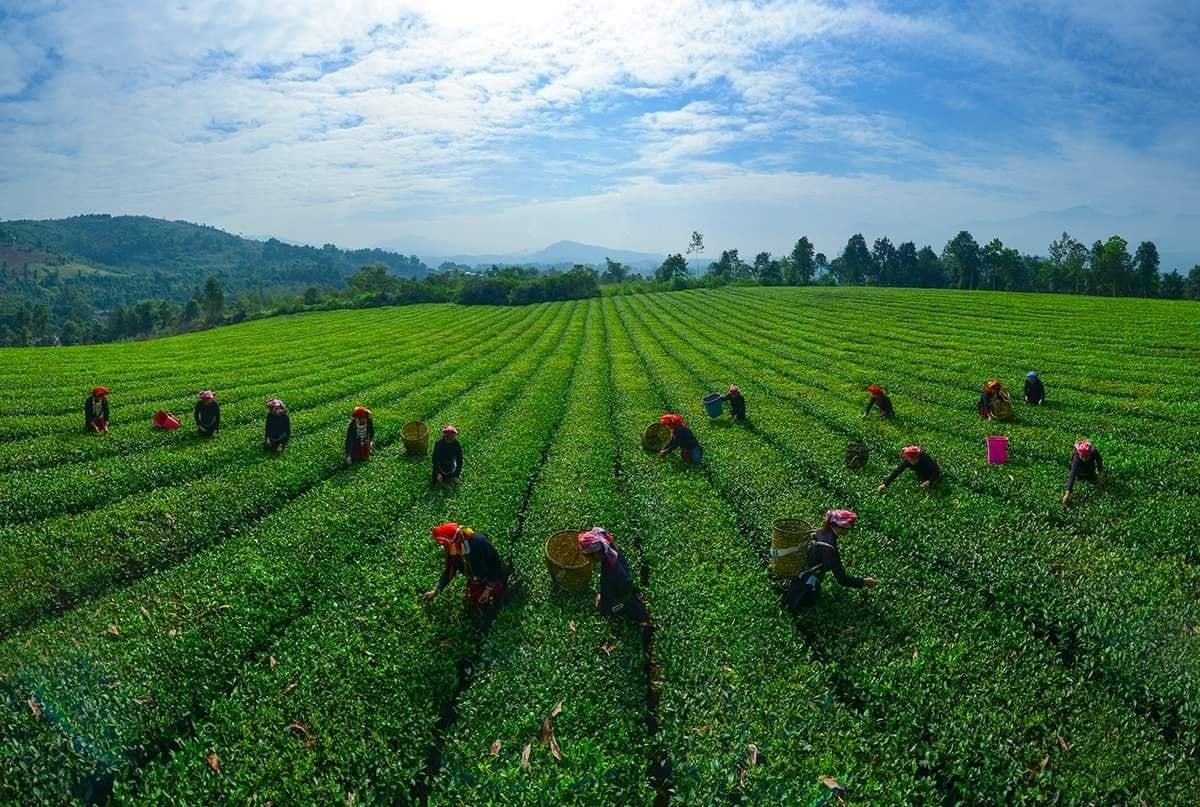June 21, 2025 | 01:34 GMT +7
June 21, 2025 | 01:34 GMT +7
Hotline: 0913.378.918
June 21, 2025 | 01:34 GMT +7
Hotline: 0913.378.918

Tea trees change the face of the countryside and the lives of people in Phu Nhuan (Bao Thang district, Lao Cai). Photo: T.N.
Mr. Do Thanh Long in Phu An 1 village, Phu Nhuan commune (Bao Thang district, Lao Cai), owning more than 3ha of Lai 2 (LDH2) tea, is one of the few households with the largest tea growing area in the village. Three years ago, he contracted the entire tea area of some other households. After that, he boldly applied scientific and technical advances in tea growing, care, and processing.
Up until now, his family's tea products have been of high quality. This year, his family is estimated to harvest about 70 tons of tea. With the selling price of VND 6,000/kg of fresh bud tea, he will earn a revenue of about VND 420 million. After deducting the cost of labor, fertilizer, etc., his family will earn a profit of VND 300 million.
Mr. Tran Quang Chuong, Chairman of Phu Nhuan Commune People's Committee, said that the whole commune currently has 177ha of tea, mainly tea for trading, including Lai 1, Lai 2, and Bat Tien tea varieties cared for according to strict regulations on safe tea production. For many years, tea has become a key crop to help many households in the commune escape poverty, improve their income, and stabilize their lives.
Tea in the commune is estimated to reach a yield of 4-5 tons/ha. Each year, the output of the whole commune reaches about 900 tons of fresh bud tea, worth over VND 5 billion. The tea tree has really played a big role in creating jobs, alleviating poverty, helping to restructure the agricultural economy, forming sustainable raw material areas, etc.
In Phong Hai town (Bao Thang district), Mr. Cu Seo Muoi in Ai Nam village was the first Mong person here to bring back tea trees to grow. His family currently has about 1.3 ha of Bat Tien tea, regularly harvesting about 6 quintals/month. With the current selling price of about VND 10,000/kg, his family earns about VND 6 million/month from selling fresh tea.
Mr. Cu Seo Muoi said that every year, the family has a revenue of about VND 36 million from tea, while the tea tree does not need a large investment and only needs weeding twice and fertilizing every year. Ai Nam village has an altitude of 1,000m, so the tea here is fragrant and delicious, with a higher price than that of other places.
Mr. Do Hong Quan, Head of the Bao Thang Department of Agriculture and Rural Development, said that over the past time, the district has continued to pay attention to implementing the program of intensive farming, developing high-quality tea areas associated with processing, and building the Bao Thang tea brand.

Tea trees bring a more comfortable life to people in the mountainous areas of Bao Thang district (Lao Cai). Photo: T.N.
Along with focusing on improving tea quality, the district will organize the implementation of new planting, replacing old and stunted tea areas with technically advanced varieties with high yield, quality, and efficiency.
Thereby, the district will form concentrated raw material areas in localities, promote production linkages with enterprises and processing facilities in the area, and support processing units in building raw material areas. Through that, both tea growers and production units can stabilize output with guaranteed tea quality.
The specialized agency of Bao Thang district will also focus on guiding tea growers to apply technical advances and invest in intensive farming to increase the yield and output of fresh bud tea. In particular, focus on state management, improving the quality and efficiency of production to meet the standards of food hygiene and safety, and raising income for people.
The whole Bao Thang district now has 509ha of tea, mainly including varieties of Bat Tien, Phuc Van Tien, O Long, etc. The output of fresh bud tea in the first six months of 2023 will reach about 1,800 tons. The consumption market is in the province and Middle Eastern countries. The price of high-quality fresh bud tea applied to the area of Ai Nam village (Phong Hai town) is VND 12,000/kg for type 1, VND 10,000/kg for type 2; and VND 5,500–6,500/kg for tea from other areas.
Translated by Huyen Vu Thu
![Turning wind and rain into action: [9] Digitizing hydrometeorological data in response to climate change](https://t.ex-cdn.com/nongnghiepmoitruong.vn/608w/files/news/2025/06/17/z6704423696987_15fd32ffc26d590d204d520c9dac6786-nongnghiep-165943.jpg)
(VAN) Farmers have begun accessing hydrometeorological applications to adjust their cropping schedules, aiming to ensure productivity and adapt to climate change.
![Turning wind and rain into action: [8] Real-time salinity detection and early warning technology](https://t.ex-cdn.com/nongnghiepmoitruong.vn/608w/files/news/2025/06/17/z6704423696987_15fd32ffc26d590d204d520c9dac6786-nongnghiep-151127.jpg)
(VAN) Thanks to the integration of modern hydrological-hydraulic models, remote sensing technologies, and artificial intelligence, the accuracy of hydrological forecasting has significantly improved.
![Turning wind and rain into action: [7] Early disaster warnings help marine farmers minimize losses](https://t.ex-cdn.com/nongnghiepmoitruong.vn/608w/files/news/2025/06/17/z6704423696987_15fd32ffc26d590d204d520c9dac6786-nongnghiep-142942.jpg)
(VAN) In recent years, thanks to early disaster warnings and forecasting, marine farmers in Khanh Hoa province have been able to reduce risks and losses, thereby improving production efficiency.
![Turning wind and rain into action: [6] ‘Four on-the-spot’ disaster management software](https://t.ex-cdn.com/nongnghiepmoitruong.vn/608w/files/news/2025/06/17/e5a48259d6a262fc3bb3-nongnghiep-183800.jpg)
(VAN) By simply activating the scenario on the disaster management software, the relevant authorities immediately know how many households need to be evacuated, where to evacuate them to, and by what means of transportation…
![Turning wind and rain into action: [5] Hue applies modern technology in disaster forecasting](https://t.ex-cdn.com/nongnghiepmoitruong.vn/608w/files/news/2025/06/17/z6704423696987_15fd32ffc26d590d204d520c9dac6786-nongnghiep-093938.jpg)
(VAN) In Hue city, modern technology has recently been applied in meteorological and hydrological forecasting and warning, helping to reduce the damage caused by natural disasters.

(VAN) A cutting-edge farming technique being implemented on an experimental ranch in Arizona's Sonoran Desert has already saved a billion gallons of water over five years, according to Civil Eats.

(VAN) Poultry and pig production and the environment can be boosted through enhanced water technology, according to new research.